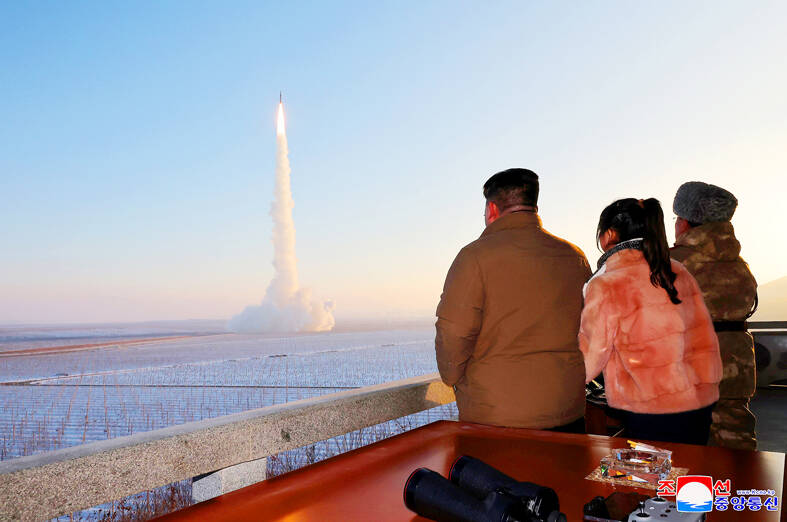North Korea appears to have started operating a light-water reactor at its main nuclear complex in a possible attempt to establish a new facility to produce bomb fuels, the US atomic agency and outside experts said.
If correct, the assessment would show that the country has taken a step toward implementing North Korean leader Kim Jong-un’s repeated vows to build more nuclear weapons.
The International Atomic Energy Agency (IAEA) has observed increased levels of activity at and near the light-water reactor at the Yongbyon nuclear complex, and since mid-October, a strong water outflow from its cooling system, IAEA Director General Rafael Grossi said Thursday.

Photo: EPA-EFE via the Korean Central News Agency
The observations were consistent with the commissioning of a light-water reactor, or LWR, Grossi said.
“The LWR, like any nuclear reactor, can produce plutonium in its irradiated fuel, which can be separated during reprocessing, so this is a cause for concern,” he said. “I repeat that the further development of [North Korea’s] nuclear program, including the construction and operation of the LWR, is a violation of UN Security Council resolutions and is deeply regrettable.”
Reent observations indicate that the water discharge seen in October is warm, an indication that the reactor has reached criticality, but without access to the facility, the IAEA cannot confirm its operational status, Grossi said.
The IAEA has not had access to Yongbyon or other locations in North Korea since 2009.
The agency has said it uses satellite imagery and open source information to monitor the North’s nuclear program.
Observers say light-water reactors are best-suited for electricity generation, but North Korea could adapt one at Yongbyon to produce plutonium for weapons.
Shin Jong-woo, a military expert at the Seoul-based Korea Defense and Security Forum, said that the Yongbyon complex is not used for producing civilian energy, so outsiders suspect the reported light-water reactor operation is related to the North’s nuclear weapons program.
“North Korea has talked about bolstering its nuclear strength and building more tactical nuclear weapons to be mounted on ballistic missiles. So [the light-water reactor operation] is suspected to be activities” to extract plutonium, Shin said.
Plutonium is one of the two key ingredients used to manufacture nuclear weapons, along with highly enriched uranium.
Yongbyon has long produced plutonium from its 5-megawatt reactor, and the light-water reactor would be an additional source.
Yongbyon also has a uranium-enrichment facility.

EXPRESSING GRATITUDE: Without its Taiwanese partners which are ‘working around the clock,’ Nvidia could not meet AI demand, CEO Jensen Huang said Taiwan Semiconductor Manufacturing Co (TSMC, 台積電) and US-based artificial intelligence (AI) chip designer Nvidia Corp have partnered with each other on silicon photonics development, Nvidia founder and CEO Jensen Huang (黃仁勳) said. Speaking with reporters after he met with TSMC chairman C.C. Wei (魏哲家) in Taipei on Friday, Huang said his company was working with the world’s largest contract chipmaker on silicon photonics, but admitted it was unlikely for the cooperation to yield results any time soon, and both sides would need several years to achieve concrete outcomes. To have a stake in the silicon photonics supply chain, TSMC and

IDENTITY: Compared with other platforms, TikTok’s algorithm pushes a ‘disproportionately high ratio’ of pro-China content, a study has found Young Taiwanese are increasingly consuming Chinese content on TikTok, which is changing their views on identity and making them less resistant toward China, researchers and politicians were cited as saying by foreign media. Asked to suggest the best survival strategy for a small country facing a powerful neighbor, students at National Chia-Yi Girls’ Senior High School said “Taiwan must do everything to avoid provoking China into attacking it,” the Financial Times wrote on Friday. Young Taiwanese between the ages of 20 and 24 in the past were the group who most strongly espoused a Taiwanese identity, but that is no longer

A magnitude 6.4 earthquake and several aftershocks battered southern Taiwan early this morning, causing houses and roads to collapse and leaving dozens injured and 50 people isolated in their village. A total of 26 people were reported injured and sent to hospitals due to the earthquake as of late this morning, according to the latest Ministry of Health and Welfare figures. In Sising Village (西興) of Chiayi County's Dapu Township (大埔), the location of the quake's epicenter, severe damage was seen and roads entering the village were blocked, isolating about 50 villagers. Another eight people who were originally trapped inside buildings in Tainan

SHARED VALUES: The US, Taiwan and other allies hope to maintain the cross-strait ‘status quo’ to foster regional prosperity and growth, the former US vice president said Former US vice president Mike Pence yesterday vowed to continue to support US-Taiwan relations, and to defend the security and interests of both countries and the free world. At a meeting with President William Lai (賴清德) at the Presidential Office in Taipei, Pence said that the US and Taiwan enjoy strong and continued friendship based on the shared values of freedom, the rule of law and respect for human rights. Such foundations exceed limitations imposed by geography and culture, said Pence, who is visiting Taiwan for the first time. The US and Taiwan have shared interests, and Americans are increasingly concerned about China’s